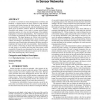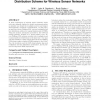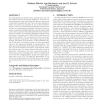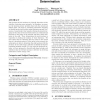WISEC
2010
ACM
14 years 12 days ago
2010
ACM
Despite increasing popularity, Location-based Services (LBS) (e.g., searching nearby points-of-interest on map) on mobile handheld devices have been subject to major privacy conce...
WISEC
2010
ACM
14 years 12 days ago
2010
ACM
As sensors in a network are mostly homogeneous in software and hardware, a captured sensor can easily expose its code and data to attackers and further threaten the whole network....
WISEC
2010
ACM
14 years 2 months ago
2010
ACM
Physical-layer identification of wireless devices, commonly referred to as Radio Frequency (RF) fingerprinting, is the process of identifying a device based on transmission imperf...
WISEC
2010
ACM
14 years 2 months ago
2010
ACM
Data breaches due to stolen laptops are a major problem. Solutions exist to secure sensitive files on laptops, but are rarely deployed because users view them as inconvenient. Thi...
WISEC
2010
ACM
14 years 7 months ago
2010
ACM
In many applications of wireless sensor networks, sensor nodes are manually deployed in hostile environments where an attacker can disrupt the localization service and tamper with...
WISEC
2010
ACM
14 years 7 months ago
2010
ACM
Key management in wireless sensor networks does not only face typical, but also several new challenges. The scale, resource limitations, and new threats such as node capture and c...
WISEC
2010
ACM
14 years 7 months ago
2010
ACM
Currently, companies are about to optimize their internal processes by monitoring items they handle with Radio Frequency Identification (RFID). However, there is a risk that sens...
WISEC
2010
ACM
14 years 7 months ago
2010
ACM
The locations of base stations are critically important to the viability of wireless sensor networks. In this paper, we examine the location privacy problem from both the attack a...
WISEC
2010
ACM
14 years 9 months ago
2010
ACM
Determining whether a client station should trust an access point is a known problem in wireless security. Traditional approaches to solving this problem resort to cryptography. B...
WISEC
2010
ACM
14 years 9 months ago
2010
ACM
Abstract A Martian who arrived on Earth today would surely conclude that computing and communications security are in a crisis situation. The popular media as well as technical pub...





